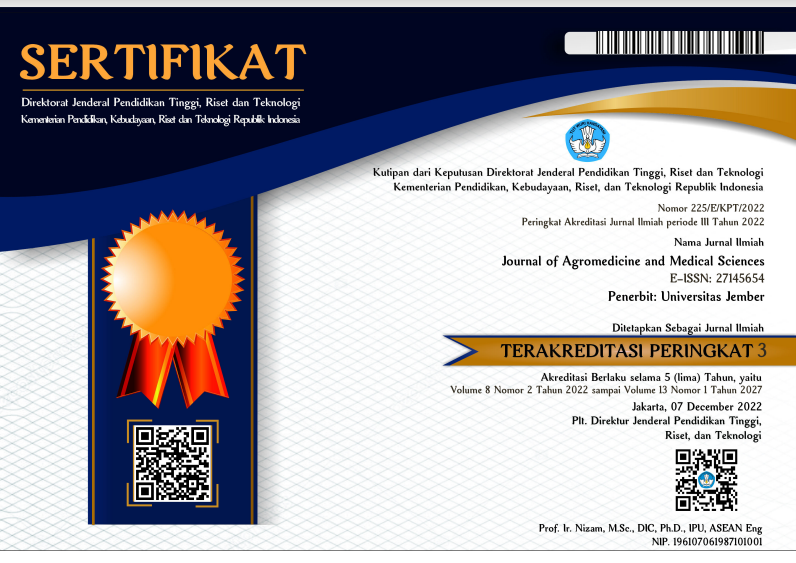Relationship between Soil-Transmitted Helminths Infection and Insulin Sensitivity in Adults at Padang City
DOI:
https://doi.org/10.19184/ams.v7i2.24117Abstract
Helminth infections in Indonesia are most often caused by Soil-transmitted Helminths (STH) species. It turns out that STH infection has a protective effect against metabolic diseases by affecting glucose metabolism and insulin sensitivity. The effect related to the immune response that caused by STH infection. The aim of this study was to investigate the relationship between STH infection with insulin sensitivity in adults at Padang City. This study design was a comparative cross-sectional study with multistage random sampling technique. Stool samples were taken from 127 adults and there were 24 subjects (18.9%) infected with STH. Furthermore, We took another 24 uninfected subjects and compared their fasting blood glucose (FBG) and fasting insulin. Then, from the data We calculated it’s Homeostatic Model for Insulin Resistance (HOMA-IR) score to assess insulin sensitivity. Unpaired T test and chi-square were used to analyze the data. The study result showed the average levels of FBG and fasting insulin were lower in STH-infected group than STH-uninfected group. However, there was no significant difference between two groups (FBG p=0.678; fasting insulin p=0.075). Also, STH-infected group tend to had good insulin sensitivity (66.7%) than STH-uninfected group (45.8%), but statistically, there was no significant relationship between STH infection and insulin sensitivity with p value=0.244. In conclusion, there is no relationship between STH infection and insulin sensitivity.
Keywords: Soil-transmitted Helminths, Insulin Sensitivity, FBG
Downloads
References
American Diabetes Association (2018) ‘Factors Affecting Blood Glucose’, Clinical Diabetes, 36(2). doi: 10.1021/cen-09203-ad10.
Brahmantya, I. B. Y., Iqra, H. H. P., Hartawan, I. G. N. B. R. M., Anjani, I. A. W., et al. (2020) ‘Risk factors and prevalence of soil-transmitted helminth infections’, Open Access Macedonian Journal of Medical Sciences, 8, pp. 521–524. doi: 10.3889/oamjms.2020.4440.
Dahlan, S. (2018) Langkah-Langkah Membuat Proposal Penelitian Bidang Kedokteran dan Kesehatan. 2nd edn. Sagung Seto.
Hussaarts, L., Garcia-Tardon, N., van Beek, L., Heemskerk, M. M., et al. (2015) ‘Chronic helminth infection and helminth-derived egg antigens promote adipose tissue M2 macrophages and improve insulin sensitivity in obese mice’, The FASEB Journal, 29(7), pp. 3027–3039. doi: 10.1096/fj.14-266239.
Jourdan, P. M., Lamberton, P. H. L., Fenwick, A., Addiss, D. G. (2018) ‘Soil-transmitted helminth infections’, The Lancet. Elsevier Ltd, 391(10117), pp. 252–265. doi: 10.1016/S0140-6736(17)31930-X.
Kelana, E., Nasrul, E., Yaswir, R. (2015) ‘Korelasi Indeks 20/(C-Peptide Puasa x Glukosa Darah Puasa) dengan HOMA-IR untuk Menilai Resistensi Insulin Diabetes Melitus Tipe 2’, 38(3), pp. 155–164. doi: 10.22338/mka.v38i3.317.
Kementerian Kesehatan (2017) PMK No.15 tentang Penanggulangan Cacingan. Jakarta.
Mishra, P. K., Palma, M., Bleich, D., Loke, P., et al.. (2014) ‘Systemic impact of intestinal helminth infections’, Mucosal Immunology. Nature Publishing Group, (April), pp. 1–10. doi: 10.1038/mi.2014.23.
Motran, C. C., Silvane, L,. Chiapello, L. S., Theumer, M. G., et al. (2018) ‘Helminth infections: Recognition and modulation of the immune response by innate immune cells’, Frontiers in Immunology, 9(APR), pp. 1–12. doi: 10.3389/fimmu.2018.00664.
Mutiara, H. (2015) ‘Immunity in Intestinal Worm Infection’, in Proceedings of Scientific Article Presentation Seminar in The 13th Dies Natalis Medical Faculty Lampung University. Lampung: Medical Faculty Lampung University, pp. 94–99.
Ni Made Nuryanti, I. M. S. (2018) ‘Soil Transmitted Helminths Infection in Elementary School’, Jurnal Kesehatan Masyarakat, 13(3), pp. 323–330. doi: https://doi.org/10.15294/ kemas.v13i3.6507.
Nugraha, T. I., Semiarty, R., Irawati, N. (2019) ‘Hubungan Sanitasi Lingkungan dan Personal Hygiene Dengan Infeksi Soil Transmitted Helminths (STH) pada Anak Usia Sekolah Di Kecamatan Koto Tangah Kota Padang’, Jurnal Kesehatan Andalas, 8(3), p. 590. doi: 10.25077/jka.v8i3.1046.doi: 10.25077/jka.v8i3.1046.
Nurhayati, Nuzulia, I., Darwin, E., Lipoeto, N., I. (2020) ‘Relationship Between Interleukin-10, Cholesterol and Blood Glucose Levels in Geohelminth Positive Adolescents and Adults’, Journal of Medical Sciences, 20(1), pp. 18–23. doi: 10.3923/jms.2020.18.23.
Pabalan, N., Singian, E., Tabangay, L., Jarjanazi, H., et al. (2018) ‘Soil-transmitted helminth infection, loss of education and cognitive impairment in school-aged children : A systematic review and meta-analysis’, PLOS Neglected Tropical Diseases, 12(1), pp. 1–31. doi: https://doi.org/10.1371/journal.pntd.0005523.
Renanti, R., Rusjdi, S. R. and Elmatris (2015) ‘Hubungan Infeksi Soil Transmitted Helminth dengan Status Gizi pada Murid SDN 29 Purus Padang’, Jurnal Kesehatan Andalas, 4(2), pp. 353–358. doi: 10.25077/jka.v4i2.253.
Rosyidah, H. N., Prasetyo, H. (2018) ‘Prevalence Of Intestinal Helminthiasis in Children at North Keputran Surabaya at 2017’, Journal of Vocational Health Studies, 01, pp. 117–120. doi: 10.20473/jvhs. v1i1.2018.117-120.
Sawant, D. V., Gravano, D. M., Vogel, P., Giacomin, P., et al. (2014) ‘Regulatory T Cells Limit Induction of Protective Immunity and Promote Immune Pathology following Intestinal Helminth Infection’, The Journal of Immunology, 192, pp. 2904–2912. doi: 10.4049/jimmunol.1202502.
Tang, Q. Li, X., Song, P., Xu, L. et al. (2015) ‘Optimal cut-off values for the homeostasis model assessment of insulin resistance (HOMA-IR) and pre-diabetes screening: Developments in research and prospects for the future’, Drug discoveries & therapeutics, 9(6), pp. 380–385. doi: 10.5582/ddt.2015.01207.
Tracey, E. F., McDermott, R. A., McDonald, M. I. (2016) ‘Do worms protect against the metabolic syndrome? A systematic review and meta-analysis’, Diabetes Research and Clinical Practice. Elsevier Ireland Ltd, 120, pp. 209–220. doi: 10.1016/j.diabres.2016.08.014.
Wiria, A. E., Sartono, E., Supali, T., Yazdanbakhsh, M. (2014) ‘Helminth Infections , Type-2 Immune Response , and Metabolic Syndrome’, Plos pathogens, 10(7), pp. 1–5. doi: 10.1371/journal.ppat.1004140.
Wiria, A. E., Hamid, F., Wammes, L. J., Prasetyani, M. A., et al. (2015) ‘Infection with Soil-Transmitted Helminths Is Associated with Increased Insulin Sensitivity’, PloS one, pp. 1–11. doi: 10.1371/journal. pone.0127746.






















